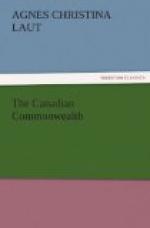If ever wildcat flourished in a gold camp or gambling joint, and that wildcat did not hie to Canada when the real estate boom broke loose, the wildcat species not in evidence was too rare to be classified. Property in small cities sold at New York and Chicago values. Suburban lots were staked out round small towns in areas for a London or a Paris, and the lots were sold on instalment plan to small investors, many of whom bought in hope of resale before payments could accrue. City taxes for these suburban improvements increased to a great burden. Fortunes were made and lost overnight. Railroad bonds were guaranteed plentifully enough to pave the prairie. All this applies chiefly to city real estate. Inflation beyond investment basis never touched farm lands; but as a prominent editor remarked, “No fool thing that ever failed was half as improbable as the fool things that have succeeded. Men have literally been kicked into fortunes; and the carefulest man has often been the biggest fool by not biting till the last.”
The boom, of course, burst of its own inflation; but it is worthy of note that the year the boom collapsed immigration reached its highest figure—four hundred thousand. Whether the boom was good or bad for Canada is hard to determine. It left a great many fortunes in its wake and a great many wrecks; but naturally it did for the country what years of hope, years of dogged silent work, years of self-confidence could not do—it jolted Canada and the world into a consciousness of the Dominion’s possibilities. It is like the true story of the finding of coal on Vancouver Island—a miner stubbed his toe and lo, a clod of earth split into a seam of shining worth!
Practically the very same story of the advent of American energy and daring and optimism into the lumber industry of Canada could be told; but it is the same story as of the mines and the land, except that the Canadians on the ground first reaped larger profits. A few years ago scarcely an acre in British Columbia was owned by interests outside the province. To-day as far north as Prince Rupert the great lumbermen of the United States own the timber limits. Canadians bought these lands round four dollars and five dollars an acre. They sold at from one hundred dollars to one thousand dollars. One understands why American lumbermen to-day demand low tariff on Canadian lumber. East of the Rockies from Edmonton to Port Arthur the fringe of timber along the great rivers and lakes is owned by operators of Wisconsin and Louisiana. In Quebec the most valuable pulp wood limits—the last of the great pulp wood limits on the continent—are owned by New York interests. Undoubtedly all this means “the Americanizing of Canada” industrially. Will it result in the entrance of Big Business into politics? That is hard to answer. The door is not wide open to Big Business in politics for reasons that will appear in an account of how Canada is governed. If Americans have entered so powerfully into Canadian industrial life, why was reciprocity rejected? That, too, is an interesting story by itself.




